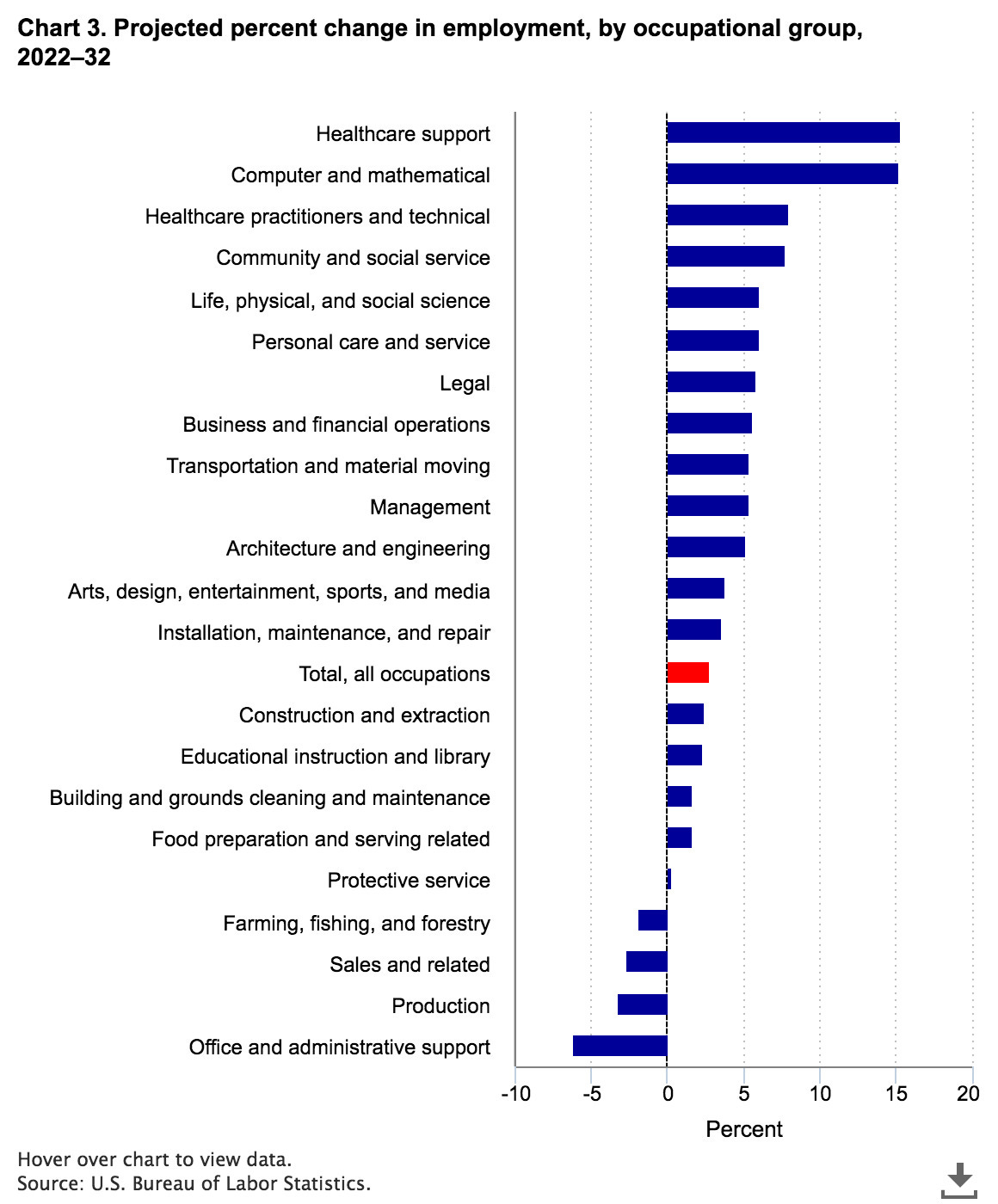There's an adage that is tossed around quite a bit in military circles, and repeated a lot in business ones as well: “Amateurs talk strategy, professionals talk logistics.”, credited to General Omar Bradley. It resonates because it is wise.
I want to offer one of my own: "Amateurs talk opportunities. Professionals talk demographics." Things you think might happen, things you might want to happen, in your organization, will only happen if they can. Demographics underlie it all. They are determinative.
You might hear about a country eager to field an army, like Ukraine; you might know of an industry eager to expand. But, lacking the people to do so, it just won't happen.
This is an oft-neglected area of analysis, one that should be the bedrock foundation of any strategic plan. It is dual-impact as well, without people, you have neither workers nor customers. Thus, you lack not only the soldiers for your army but also the economy to fund them.
Whether you are a small business owner, a manager of department, or a leader of a large organization, it is critical that you continue to refine your skills at understanding your customer and employee demographics.
I hemmed and hawed a bit in picking an illustration for this, as there are so many interesting ones. Take, for instance, the recent news story of the USNS Big Horn, a replenishment oiler of the United States Navy. It's more than 30 years old and recently ran aground while fueling our vessels in the Middle East. It's old, it's damaged, and we don't have a replacement. Worse, you learn when you dig a bit, this problem is an epidemic in our Navy; we've recently laid up nearly two dozen such transport ships, as WE CAN'T MAN THEM. We don't have the merchant mariners today, and we don't have them in the pipeline. This is a matter of national security.
I also remembered a time when I was just out of graduate school, looking at a rosy projection for the growth of management consulting services. I looked at the hockey-stick-shaped growth chart and thought to myself, there can't be enough students in all of the business schools in the world to hit those numbers! We don't make kids, make students, or make grad students fast enough!
Do you know of other examples of worker-constrained industries or projects? Share them in the comments.
Ultimately, I settled upon an example to use: Will we have enough young, computer science and math grads to meet projected needs? Let's take a look, step-by-step. Develop your own thoughts about the quality of the data and what assumptions lie within.
COMPUTER AND MATH OCCUPATIONS ARE FORECAST TO GROW 15 PERCENT OVER THE NEXT DECADE
According the U.S. Bureau of Labor Statistics, "Industry and occupational employment projections overview and highlights, 2022–32", employment growth in the coming decade is projected to be about three percent, down considerably from the 13 percent we experienced between 2012-22. Many job categories won't grow at all, and even more will, in fact, shrink. The bright spots are the healthcare and social assistance sector and the professional, scientific, and technical services sector, the two sectors with the strongest job growth.
Looking at the detail, one sees the subcategory, Computer and Mathematical - - well-paying jobs requiring higher education - - with strong prospects, projected to grow 15 percent over the next decade, the second-largest increase in jobs from 2022 to 2032 (803,800), nearly tied with the fastest-growing job category, Healthcare Support.
NUMBER OF COLLEGE GRADUATES - - ESPECIALLY STEM GRADUATES - - SOARED OVER THE LAST DECADE
The Department of Education’s "2022 Condition of Education" report details this growth. The total number of bachelor’s degrees conferred increased by 24%. A stable trend, women got three of every five degrees conferred. Females earned the majority of degrees in these four fields: health professions and related programs (85%); psychology (80%); biological and biomedical sciences (66%); social sciences and history (53%). Males earned the majority of degrees conferred in engineering (75%) and business (53%).
STEM degrees were one-fifth of the total conferred. Some STEM fields saw enormous growth over the decade:
Computer and Information Sciences, with a gain of 245%;
Math and Statistics, up 70%;
Engineering/Engineering Technology, up 67%;
Biology and Biomedical Sciences, a 47% increase.
So, we see that we created a lot of STEM grads over the past decade, and we had the economy to employ them. What can we say about the future? What does the next decade hold?
NUMBER OF BIRTHS DRIVES NUMBER OF COLLEGE-BOUND
This is a first principal. Let's take a look at births.
Graduates in the college Class of 2024 were born around 2002. As we are trying to understand what will happen in the next decade, note we go from 4.02 million live births in 2002 to 3.95 million by 2012, the college Class of 2034. The bar chart, in blue, shows a little boomlet in 2006-08 - - the college classes of 2028-30, but then it continues downward and is expected to do so in the future.
See also the astonishing drop in births between the 2007 peak of 4.3 million and 2022's 3.7 million figure - - this translates into 700,000 "missing" people, both workers and consumers! [Take a gander at the first chart: This missing 700K is nearly the size of the expected 800K growth in "Computer and Mathematical" …egad!]
Data published by the Congressional Budget Office (CBO) paints a similar picture, no growth in the number of young people.
One more look. See the 2024-2025 bump in high school grads? Those are the babies from that 2006-08 baby boomlet. Note again that downward-sloping, troubling trend line going forward.
HOW DO YOU GET MORE STEM GRADUATES AND WORKERS WITHOUT THE BABIES?
The Dept. of Ed's "Bachelor's degrees conferred by postsecondary institutions, by field of study: Selected academic years, 1970-71 through 2021-22" data tells us what happened.
Students substituted STEM degrees in place of others. We got more technology and health care workers by creating fewer of everything else. This occurred even during periods of increased enrollments.
Education, English, Social Sciences, Foreign Languages, Liberal Arts, and Humanities all registered very large declines.
The growth in the health and computer fields cannibalized other majors and fields of study.
CONTINUED GROWTH IN COMPUTER- AND MATH-RELATED OCCUPATIONS WILL, AGAIN, COME AT THE EXPENSE OF OTHER DISCIPLINES
There is no other way employment growth can happen. Further, this effect will be even more dramatic in the coming era when the supply of new college graduates is flat or in decline.
I'm skeptical that the substitution trend can continue. We students of economics like to think that everything happens at the margin. Hasn't that groundswell of STEM in the last decade made other jobs, other majors, more valuable, more lucrative? I should think so. A "cooking off" of sorts has likely happened as well, where the remaining English, German, and Philosophy majors are likely to be very committed ones.
Another belief I hold is that humans are not - - extremely - - fungible. I can be a serviceable mechanic, but probably not a great one. I recall, as a freshman Chemical Engineering major, taking an Honors Computer Science class [Yes, I was that foolish]. We covered four languages in the one semester. Sure, I could do it, but as any honest person with any experience coding will tell you, some individuals are better suited for this than others.
Can every English major become a nurse? Should she? Further, is this desirable for her, or for society? I don't thick so.
ADDITIONAL HEADWINDS MAKE ROSY STEM EMPLOYMENT GROWTH PREDICTIONS SEEM SHAKY
First, we have entered an era of college closures, due to declining enrollments and the resulting decline in tuition revenues. According to Rachel Burns of the State Higher Education Executive Officers Association (SHEEO), over 500 colleges have closed in the last decade.
An economist at Carleton College in Minnesota, Nathan Grawe, expects the number of college-bound to fall 15 percent between 2025 and 2029 and to fall a percent or two further after that. It is not only the declining birthrates driving this trend but also the increasing number of young people that are pursing career paths other than college. This creates a "death spiral" as distressed colleges with smaller student bodies become increasingly less safe and attractive choices for more young people.
Second, while still nascent, AI is expected to impact computer- and mathematics-related fields. Currently, experts say it will "simplify" the job and make it "more accessible", but aren't these descriptions euphemistic? It will lower the number of professionals required for these tasks, it will "unemploy" them. Wouldn't we also expect this to dampen compensation growth?
Third, a sluggish economy will suppress the growth in STEM employment. The BLS study cited above mentions that we experienced 13 percent job growth in the last decade and expect only three percent this decade - - a ten percent decline. This does not sound like a robust economy. Sounds like stagflation to me. [See my post, "Money for Nothing."]
Finally, many STEM workers are unhappy. A 2024 Stack Overflow survey found only 20% of professional developers were "happy" with their job, with 30% being "unhappy" and 50% "complacent". While paid well, and generally having high job security and flexibility, workers cite the high job stress, the unhealthy lifestyle, the frequent layoffs, and the disillusionment at being a "cog" in a corporate bureaucracy as reasons for low overall job satisfaction. See my post "Sticks? All out. Carrots? Running Low."
My bet: We never hit those "Computer and Mathematical" employment projections for two reasons: 1) We lack the workers to staff at that level; 2) AI and a weak economy suppress the need for that staffing level.
DIGGING DEEPLY INTO YOUR CUSTOMER AND EMPLOYEE DEMOGRAPHICS YIELDS VALUABLE INSIGHTS, INSIGHTS THAT WILL IMPROVE YOUR STRATEGIC PLAN
We unearth issues that help attract, train, and retain our workforce. Where are the people you will need? What do they value? How is this changing?
We unearth issues that let us better serve our customers and clients. Who is that customer today? Who is that customer tomorrow?
Where are your future employees and customers? What do you know about them?
This is the bedrock foundation of any strategic plan.













Good article!